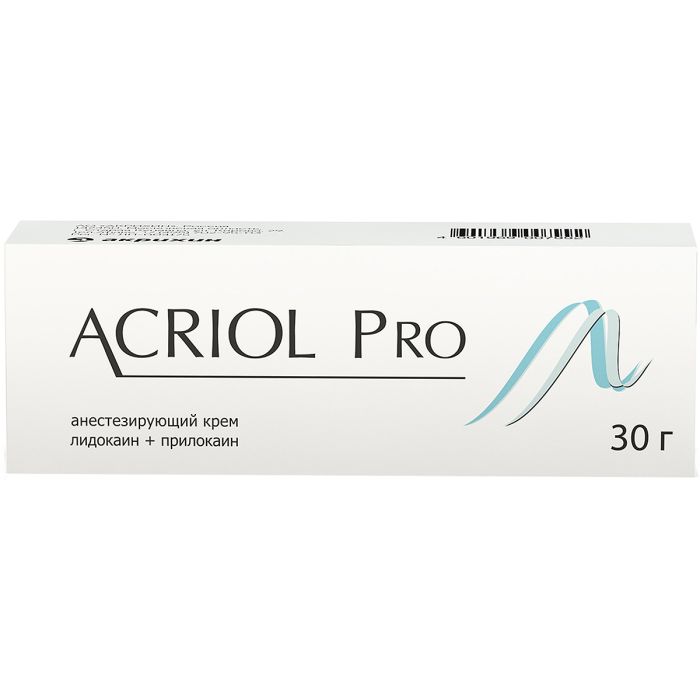Acriol Pro cream for external use 2.5% + 2.5% tube 30g # 1
Dosage:
2.5% + 2.5% x 30g
2.5% + 2.5% x 5g
Category
Anesthesia and muscle relaxants
Scope of the drug
Dermatology
Release form
Cream
Manufacturer country
Russia
Package quantity, pcs
one
pharmachologic effect
Local anesthetic
Indications
In adults:
- surface anesthesia of the skin during injections (including during vaccination), punctures and catheterization of blood vessels and superficial surgical interventions, including minor cosmetic procedures and epilation
- surface anesthesia of trophic ulcers of the lower extremities during surgical treatment (mechanical cleaning), for example, to remove fibrin, pus and necrotic tissues
- surface anesthesia of the genital mucosa before painful manipulations and for anesthesia before injections of local anesthetics.
In children:
- surface anesthesia of the skin during injections (including during vaccination), punctures and catheterization of blood vessels and superficial surgical interventions (including when removing molluscum contagiosum).
Contraindications
Hypersensitivity to local anesthetics of the amide type or any other component of the drug.
Premature infants born before 37 weeks of gestation.
Newborns weighing less than 3 kg.
Carefully:
Deficiency of glucose-6-phosphate dehydrogenase, hereditary or idiopathic methemoglobinemia, widespread neurodermatitis (atopic dermatitis), patients taking class III antiarrhythmic drugs (eg, amiodarone).
Application during pregnancy and lactation
Pregnancy
There is insufficient data on the use of the drug in pregnant women.
In the course of studies on animals, no direct or indirect negative effects of the drug on pregnancy, intrauterine development of the fetus, on the process of childbirth or postnatal development were revealed.
Lidocaine and prilocaine cross the placental barrier and can be absorbed into the fetal tissues.
No specific reproductive disorders have been reported, such as an increase in the incidence of malformations or other direct or indirect adverse effects on the fetus.
Breastfeeding period
Lidocaine and prilocaine are excreted in breast milk in quantities that do not pose a risk to the child, when using the drug in therapeutic doses.
special instructions
Patients with glucose-6-phosphate dehydrogenase deficiency or hereditary or idiopathic methemoglobinemia are more prone to drug-dependent methemoglobinemia.
The effectiveness of using the drug in newborns during the procedure for taking blood samples from the heel has not been established.
Care should be taken when applying Acriol Pro around the eyes, as it irritates the eyes.
Eliminating protective reflexes can irritate or damage the cornea.
In case of contact with the eyes, immediately flush the eyes with water or 0.9% sodium chloride solution, and protect the eyes until the protective reflexes are restored.
Care must be taken when applying the drug to the skin with atopic dermatitis
application time should be reduced (15-30 minutes).
In children under 3 months of age, the safety and efficacy of the drug was determined after applying a single dose.
In such children, after application of the drug, a temporary increase in blood methemoglobin levels was often observed, lasting up to 13 hours.
However, the observed increase in the content of methemoglobin in the blood is probably not of clinical significance.
Patients taking class III antiarrhythmics (eg, amiodarone) should be monitored and ECG monitored closely.
possible influence on cardiac activity.
Do not apply the drug to a damaged eardrum or in other cases of possible drug penetration into the middle ear.
Do not apply Acriol Pro to open wounds.
Due to the lack of data on the absorption of the drug, it is not recommended to apply the drug to the genital mucosa in children.
Lidocaine and Prilocaine B
Name ENG
AKRIOL PRO
Clinical and pharmacological group
Local anesthetic for surface anesthesia
ATX code
Combined drugs
Dosage
2.5% + 2.5% x 30g
Structure
100 g of cream contains: active ingredients: lidocaine - 2.5 g, prilocaine - 2.5 g
excipients: PEG-54 hydrogenated castor oil - 1.9 g
carbomer - 1.0 g
sodium hydroxide - 0.52 g
purified water - up to 100 g.
Indications
In adults: - surface anesthesia of the skin during injections (including vaccination), punctures and catheterization of blood vessels and superficial surgical interventions, including minor cosmetic procedures and epilation
- surface anesthesia of trophic ulcers of the lower extremities during surgical treatment (mechanical cleaning), for example, to remove fibrin, pus and necrotic tissues
- surface anesthesia of the genital mucosa before painful manipulations and for anesthesia before injections of local anesthetics.
In children: - surface anesthesia of the skin during injections (including during vaccination), punctures and catheterization of vessels and superficial surgical interventions (including when removing molluscum contagiosum).
Contraindications
Hypersensitivity to local anesthetics of the amide type or any other component of the drug.
Premature infants born before 37 weeks of gestation.
Newborns weighing less than 3 kg.
, With caution: deficiency of glucose-6-phosphate dehydrogenase, hereditary or idiopathic methemoglobinemia, widespread neurodermatitis (atopic dermatitis), patients taking class III antiarrhythmic drugs (eg, amiodarone).
Storage conditions and periods
At a temperature not exceeding 30 degrees. (Do not freeze).
Expiration date: 2 years
INN / Active ingredient
lidocaine, prilocaine
Specifications
Category
Anesthesia and muscle relaxants
Scope of the drug
Dermatology
Release form
Cream
Manufacturer country
Russia
Package quantity, pcs
one
Minimum age from
From birth
Way of introduction
Locally
Vacation conditions
Without recipe
Brand name
Akrikhin
The amount of the dosage form in the primary package
30 g
Primary packaging type
Tuba
Type of consumer packaging
Pack of cardboard
Pharmaco-therapeutic group
Local anesthetic
Dosage form
Topical and topical cream
Expiration date in days
730
The target audience
Children
Package weight, g
40
Mode of application
:
Outwardly, on the skin or mucous membrane.
< br> Superficial anesthesia of trophic ulcers of the lower extremities.
Anatomical and therapeutic characteristics
:
N01BB20 Local anesthetics, in combination with other drugs
Information on technical characteristics, delivery set, country of manufacture

